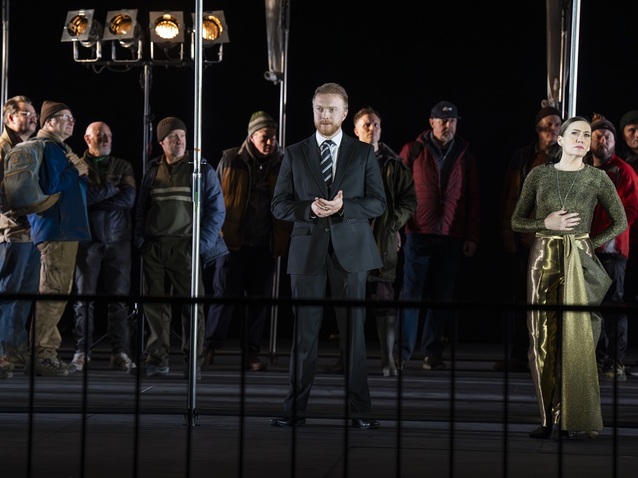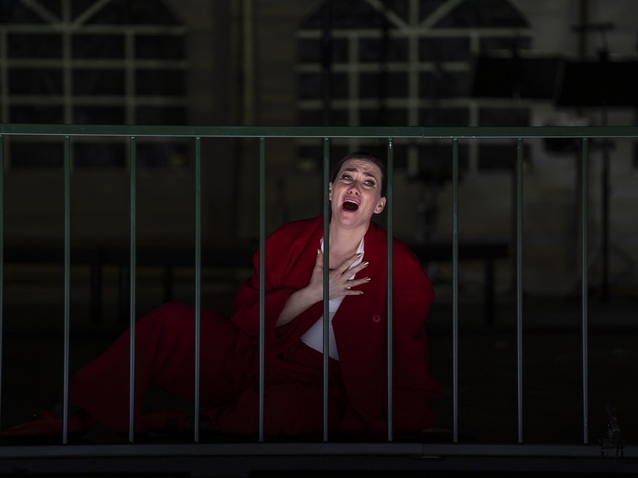 Mary, Queen of Scots 2025 © Ellie Kurttz
Mary, Queen of Scots 2025 © Ellie Kurttz
Mary, Queen of Scots, a commission by Scottish Opera that premiered at the Edinburgh Festival in 1977, is the first of Thea Musgrave’s four operas on historical figures. It is also the first for which she wrote her own libretto, with her starting point being an unpublished play by Amalia Elguera, who had previously written the libretto for Musgrave’s 1973 opera The Voice of Ariadne.
While there have been plays and operas about the character before, the majority have focused, like Gaetano Donizetti’s Maria Stuarda, on her rivalry with Queen Elizabeth I once she is a prisoner in England. In contrast, Musgrave’s opera considers the events between 1561 and 1567 that led her to abdicate and flee to that country to start with. Beginning with Mary’s arrival back in Scotland to assume the Scottish crown, following the death of her husband Francis II of France, it sees three men vie for her favour. They all claim they are the only one who can protect Mary, but each is predominantly interested in gaining power for themselves, although two of them are certainly attracted to her while the third claims he loves her as a sister.
This final figure is her half-brother James Stewart, Earl of Moray, who is really scheming to take the throne himself. The others are Mary’s cousin Henry Stuart, Lord Darnley, who she marries, and James Hepburn, Earl of Bothwell. As they battle for supremacy, the plotting and murders that abound all implicate the Queen to the point where she is forced to flee the country alone, no matter how innocent she may be. The story as it is told plays fast and loose with several historical facts, but it captures the manner in which all of these battles take place against a fight for the very soul (in other words religion) of the country.

Alex Otterburn, Heidi Stober and the cast of ENO’s Mary, Queen of Scots 2025 © Ellie Kurttz
This is the English National Opera premiere of the work, and Stewart Laing’s staging, which represents a co-production with San Francisco Opera, is lo-tech but highly effective. As the people enter the auditorium, they watch a marquee being erected. This continues to be raised across the first Act, and by the time of the scene at the ball lights and sound systems have been fitted to make it the ultimate place for a party. This works because sixteenth century Scottish palaces, while being luxurious compared with other buildings around them, would not have been overwhelmingly ostentatious like Louis XIV’s Versailles. They would have been cold, damp and draughty, and so the ‘rough and ready’ feel that the staging offers the proceedings makes the overall atmosphere feel commensurate with that of the original setting.
Everyone is dressed in contemporary clothes, and this does universalise the opera’s themes and make them more relatable. At the same time, even without the costumes stipulating the original time and place, there is something that makes us feel a connection to it so that we do not merely witness a generalised tale. Much of the reason for this can be attributed to Musgrave’s score, which seems to combine something of the British opera sound world of the 1970s with a few Scottish folk-style melodies. When the character of David Riccio first sings at the ball, it feels slightly reminiscent of The Spirit of the Masque leading the entertainment at one of Elizabeth I’s balls in Benjamin Britten’s Gloriana. After this, it goes in quite a different direction but the opera nonetheless feels a little like a Scottish ‘equivalent’ to Britten’s opera, which had only been written twenty-four years earlier in 1953.

Heidi Stober, ENO’s Mary, Queen of Scots 2025 © Ellie Kurttz
The associate costume designer is Mady Berry, and when everyone first appears they wear (in most cases puffer) jackets. This alludes to Scotland’s cold climate, but also puts everybody on something of a level playing field so that we gain a keen sense of the country as a community made up of many parts. Then, however, as these are removed, and we see a wide variety of clothes from sharp suits to clerical attire, the hierarchies at play come into sharper focus. Mary herself wears several costumes from stylish dresses at the ball to bright red to simple brown clothes that suggest sackcloth and ashes. These allude partly to the idea of facades and appearances, for when Mary claims that not everything is as it seems, her ally Lord Gordon replies that unfortunately it is how things seem to people that matters. The staging is also impactful by virtue of its restraint. Both a murder and a rape see the people obscure the act by crowding around it, thus leaving its true terribleness to the imagination.
Joana Carneiro’s conducting is excellent, while there are strong performances from Alex Otterburn as James, Rupert Charlesworth as Darnley, John Findon as Bothwell, Barnaby Rea as Riccio, Darren Jeffery as Cardinal Beaton and Alastair Miles as Gordon. The standout contribution, however, comes from Heidi Stober as Mary whose soprano is deeply compelling and immensely well shaped. Throughout the opera the degree to which she actually demonstrates strength, intelligence and diplomacy makes it seem especially unfair she should be so completely defeated. When she banishes Bothwell one can see the tension between her wishing to exert her authority as Queen and recognising the tact she must employ. The most heart breaking moment of all, however, comes at the end at the sight of the exiled Queen standing alone in the front row of the stalls singing across the orchestra pit to the stage to the country she has now so tragically lost.
By Sam Smith
Mary, Queen of Scots | 15 - 18 February 2025 | London Coliseum
the 18 of February, 2025 | Print
Comments